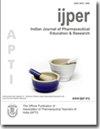Design, Development and Optimization of Buccal Tablet Containing Extract of Terminalia chebula Retz. for the Treatment of Asthma
IF 0.8
4区 医学
Q3 EDUCATION, SCIENTIFIC DISCIPLINES
Indian Journal of Pharmaceutical Education and Research
Pub Date : 2023-10-04
DOI:10.5530/ijper.57.4.121
引用次数: 0
Abstract
Abstract: Objectives: The aim of the study was to design, develop, and optimize the buccal tablets containing extract of Terminalia chebula Retz. for the treatment of asthma. Materials and Methods: Buccal tablets were made using the direct compression method, and screening tests with various polymers were run to see how they affected the properties of the tablets. The utilisation of response surface methods, two polymer types, carbopol® and HPMC, were chosen for additional optimization research. Strength of mucoadhesion and % two significant responses that the drug permeated after 8 hr from the buccal mucosa were chosen. By using a swelling index analysis, the profiles and kinetics of in vitro drug release were examined. Results: The Terminalia chebula Retz. content in buccal tablets was determined to be 99.14±0.44%, and a DSC analysis showed that there was no chemical interaction between the ingredients of the tablet (8 g carbopol 934 and 20 g HPMC K15 made up the optimal formulation). After 8 hr of in vitro dissolving studies, a cumulative Terminalia chebula Retz. release of 90% was reached, which was confirmed by swelling analysis. Conclusion: The findings suggested that Terminalia chebula Retz's. optimised buccal tablets would be a promising and different delivery method for the treatment of asthma. Keywords: Terminalia chebula Retz., Buccal tablet, HPMC K15, Optimization, Carbopol, DoE莪术提取物口腔饮片的设计、研制与优化。用于治疗哮喘
【摘要】目的:设计、研制和优化莪术提取物口腔片。用于治疗哮喘。材料与方法:采用直接压缩法制备口腔片,并对不同聚合物对口腔片性能的影响进行筛选试验。利用响应面法,选择两种聚合物,carbopol®和HPMC进行进一步的优化研究。选择黏附强度和8小时后药物从口腔粘膜渗透的两种显著反应。通过溶胀指数分析,考察了该药物的体外释放情况和动力学。结果:枳实。口腔片的含量为99.14±0.44%,DSC分析表明片剂成分之间无化学相互作用(卡波醇934 8 g与HPMC K15 20 g为最佳配方)。经过8小时的体外溶解研究,累积的chebula Retz。溶胀分析证实其释放度达90%。结论:研究结果表明,慈母属植物具有一定的药用价值。优化的口腔片将是治疗哮喘的一种有前途的和不同的给药方法。关键词:天竺葵;,口腔片,HPMC K15,优化,卡波波尔,DoE
本文章由计算机程序翻译,如有差异,请以英文原文为准。
求助全文
约1分钟内获得全文
求助全文
来源期刊
CiteScore
1.40
自引率
0.00%
发文量
227
审稿时长
>12 weeks
期刊介绍:
The official journal of Association of Pharmaceutical Teachers of India (APTI) and is being published since 1967. IJPER, a quarterly publication devoted to publish reviews and research articles in pharmacy and the related disciplines of Pharmaceutical education. It mainly covers the articles of special interest, covering the areas of Pharmaceutical research, teaching and learning, laboratory innovations, education technology, curriculum design, examination reforms, training and other related issues. It encourages debates and discussions on the issues of vital importance to Pharmaceutical education and research. The goal of the journal is to provide the quality publications and publish most important research and review articles in the field of drug development and pharmaceutical education. It is circulated and referred by more than 6000 teachers, 40,000 students and over 1000 professionals working in Pharmaceutical industries, Regulatory departments, hospitals etc.

 求助内容:
求助内容: 应助结果提醒方式:
应助结果提醒方式:


